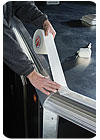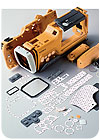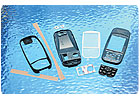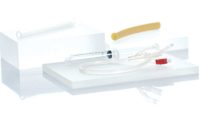
A worker applies a thin-film bonding system. Pressure-sensitive foam tapes and adhesive transfer tapes can accommodate expansion and contraction cycles. Photo courtesy Fabrico.
Many of today’s products must be designed to deliver long service lives while operating in harsh environments. The most striking example is NASA’s space shuttle, which is subjected to extreme dynamic and static stresses, temperatures and radiation during launch and re-entry.
To keep the shuttle’s aluminum structure below 350 F during re-entry when ambient temperatures reach 2,300 F, much of the vehicle’s underside, which takes the brunt of frictional heat, is covered with 24,300 silica insulation tiles.
These tiles are not mechanically fastened to the vehicle but glued to felt strain-isolation pads with silicone adhesive. The pads, which in turn are bonded to the underlying aluminum vehicle skin, isolate the brittle tiles from the orbiter’s structural deflections and expansions.
However, you don’t need to go into outer space to find difficult environments that test the ability of adhesives to perform under extreme conditions. Look at military and commercial aircraft, which also are subjected to extreme stresses and temperatures (from tropical at ground level to sub-zero at cruising altitudes), as well as weather (humidity, rain) and chemicals (corrosive salt spray, solvents and jet fuel).

Adhesives Characteristics
Guide 1. Source: Fabrico.
The reason is because, in many situations, these products are superior to rivets, spot welds, thermal joining, rigid liquid adhesives and other permanent fasteners for joining substrates such as metals, plastics, rubbers and glass. The main advantages of these adhesives and thin-film bonding products include:
*distributing rather than concentrating stress loads,
*accommodating flex and vibration,
*separating potentially reactive metals,
*forming seals that conform to joints and protect them from corrosion.
Designers can choose from several families of liquid adhesives and flexible thin-film bonding systems that resist environmental stress and degradation. Selecting the best adhesive depends on several application factors:
*substrates to be bonded,
*maximum and minimum temperature requirements,
*extent of thermal cycling, vibration and other physical stresses,
*exposure to ultraviolet (UV) radiation, moisture, humidity, salt spray, chemicals and solvents,
*production and processing requirements.

Adhesives Characteristics Guide 2. Source: Fabrico.
Liquid Adhesives
Liquid adhesives are available in new fast-cure, easily dispensed formulations that deliver excellent moisture resistance, chemical resistance and strength in high temperatures. Types include anaerobics, hot-melts, polyurethanes, acrylics, epoxies and silicones.Anaerobicsare one-part adhesives that cure in the absence of air into temperature-resistant, thermoset plastics. They function at temperatures up to 160 F and are resistant to water, mild solvents and hydrocarbons.
Hot-meltsare thermoplastic compounds. Supplied in solid form, they are melted and applied as flowing liquids. A bond is formed when they cool between substrates. Chemistries include polyamides, polyolefins, reactive urethane and ethyl vinyl chloride. Because they soften as temperatures rise, hot-melts are generally limited to a maximum temperature of about 160 F. A chief advantage of hot-melts is their short setup time, which eliminates the need for fixtures to hold parts in place.
Polyurethanesare one- and two-part adhesives that are tougher than epoxies because they combine flexibility and cohesive strength. They also have greater flexibility, better peel strength and lower modulus than epoxies. Polyurethane formulations have good chemical resistance and can withstand temperatures from 160 F to 300 F. However, moisture can impair bonding performance and appearance, and long-term exposure to high temperatures will degrade polyurethanes more rapidly than epoxies.
Acrylicsare available in either one- or two-part formulations. One-part, solvent-free, light-cure acrylics set up in seconds. Formulated for flexibilities ranging from soft to brittle, they have very good thermal, chemical and environmental resistance.
Two-part acrylics have equally good environmental properties. Acrylic formulations are available to withstand maximum temperatures of 160 F to greater than 400 F, rivaling the performance of some epoxies.
Epoxiesare one- and two-part structural adhesives that, when cured, have very good chemical resistance and exceptional fluid resistance. Certain formulations can withstand temperatures greater than 400 F. They are very rigid and inflexible. One drawback to epoxies is their relatively long cure times of up to two hours.
Siliconescan withstand very high temperatures. These adhesives retain their properties even at temperatures of 450 F to 700 F. They are softer and more flexible than rigid, highly cross-linked acrylic and epoxy formulations. However, silicone doesn’t provide the bond strengths of acrylic, epoxy or polyurethane.

When assembled, this underwater camera contains several
small and large pieces of water-resistant adhesive tape. Photo courtesy
Fabrico.
Thin-Film Bonding Systems
Although flexible, thin-film bonding systems have been available for about 25 years, recent advances are attracting a new generation of designers and manufacturers to these adhesives. These new bonding systems includeconformable foam tapes, adhesive transfer tapes and adhesive peel-and-stick masksthat can be die cut to precisely fit any shape, size or profile.The foam and transfer tapes are all-acrylic, pressure-sensitive systems. They prevent bimetallic corrosion, and offer high holding strength and better versatility compared to conventional fasteners and adhesives. Foam and transfer tape adhesives bond parts instantly, eliminating the need for fixtures and long cure times, as well as drilling, grinding, refinishing, screwing, welding and cleanup.
Because of their viscoelasticity, tape adhesives absorb shock and flexing, and improve resistance to fatigue caused by environmental factors, such as wind, vibration, and substrate expansion and contraction from temperature cycling. This ability means tapes can replace rivets, spot welds, some liquid adhesives and other permanent fasteners in many applications.
Rigorous environmental testing and years of use in critical applications have shown that flexible, thin-film bonding systems can tolerate periodic, short-term temperature extremes up to 300 F for foam tapes and 500 F for adhesive transfer tapes. These systems also are highly resistant to heat, UV, water, saltwater and chemical attack. They can strongly bond oily surfaces, such as steel and vinyl in the presence of plasticizers.
In accelerated weathering tests-which expose stainless steel strips bonded with foam tape to heat, UV and humidity-bond strength does not deteriorate below its original level after 7,000 hours.
Foam tapes range in thickness from 0.015 to 0.12 inch. Outdoor weathering for two to five years shows foam tapes retain 100 percent of their bond strength with aluminum, glass, PVC and painted metal in climates ranging from hot and humid, to hot and dry, to cyclical cold and hot extremes.
Aluminum-to-aluminum foam-tape bonds submerged in 5 percent saltwater and tap water show continued high-performance levels after 10 years. When the adhesive is removed, bright aluminum surfaces are exposed.

Cell phones contain
thin-film bonding systems, which attach and seal components against moisture,
heat and corrosive solutions. Photo courtesy Fabrico.
Assembly Applications
Liquid Adhesives. Liquid adhesives deliver strong, tough and reliable bonds on metals, plastics, composites, polyolefins and other substrates.General-purpose structural adhesives are widely used in agricultural and construction equipment, specialty vehicles, furniture, appliances, signage, tubs and spas, and architectural components where metal-to-metal, rubber-to-metal, plastic-to-metal and glass-to-metal bonding can be a challenge. Application and curing can be automated to speed production and reduce labor costs.
Similarly, adhesive formulations for low-surface-energy materials can bond fiberglass, gelcoat, thermoplastics, polycarbonate, ABS, PVC, polyethylene and polypropylene. Flexible adhesives have fast fixture times, good bond clarity and UV resistance, which is particularly important in outdoor applications.
More specifically, anaerobics are used primarily to bond metal substrates. Polyamides, which are hot-melt compounds, are used for potting applications where higher-temperature resistance is needed. Polyolefins, another hot-melt compound, provide good moisture resistance and adhesion to low-surface-energy plastics (polyethylene, for example), and resistance to polar solvents, acids, bases and alcohols.
One-part acrylics create high bond strengths with a wide variety of substrates. Two-part acrylics form strong, flexible bonds with many metals and plastics, giving them long-term fatigue resistance and durability. Acrylics also have the ability to form strong bonds on oily metal surfaces, such as cold-rolled steel.
Silicones are useful as sealants and gaskets because of their resistance to nonpolar solvents like gasoline and oil, their ability to form a protective surface seal at the bond line to prevent the corrosive effects of water and salt water, and their resistance to extreme temperatures.
Thin-film Bonding Systems. Foam tapes and transfer tapes provide toughness and durability for applications that demand strength and flexibility. These pressure-sensitive bonding systems are based on acrylic formulations that assure instant adhesion to a specific material or a broad range of materials-from high-surface-energy substrates (aluminum, steel) to difficult-to-bond, low-surface-energy plastics (polypropylene, powder-coated substrates).
One of the most demanding applications of a thin-film bonding system is aircraft exteriors. In several commercial aircraft models, stainless steel anti-chafing strips are bonded to aluminum wing flaps with adhesive transfer tape. These strips help prevent abrasion and chafing between the flap and the underside of the wing during deployment of the flaps for takeoffs and landings.
Bond durability and resistance to environmental extremes is a key requirement for this application because the bond often is subjected to high skin temperatures in direct sunlight on the ground and -64 F at high altitude. This extreme temperature cycle may be repeated several times a day.
Another demanding and visible application of foam bonding tapes is in ambulances, where aluminum body panels are bonded to the vehicle frame. This application requires durability and performance over an extended period of time.
In the automotive industry, thin-film bonding systems are successfully used to invisibly adhere window switch plates and other plastic trim pieces to vinyl substrates, eliminating unsightly fasteners. Plasticizers compounded in soft vinyl can migrate into adhesives and significantly degrade their performance. The tapes are specially formulated to bond strongly to vinyl and resist the effect of plasticizers.
Water- and UV-resistant thin-film bonding systems are also available. Water-resistant systems are used to adhere saltwater keel protectors to boats. UV-resistant systems are used on solar energy collectors to bond panels to support frames and affix electric power collection buses to the assemblies. Finally, a range of personal electronic and medical devices use thin-film bonding systems to attach and seal components against moisture, heat, cleaning solutions and corrosive fluids.
ASSEMBLY ONLINEFor more information on adhesives, check out these articles:

